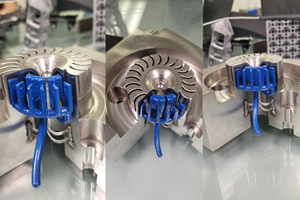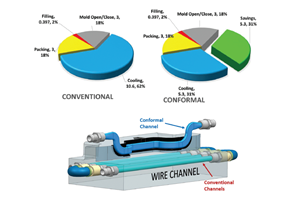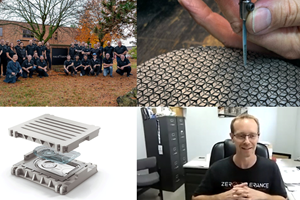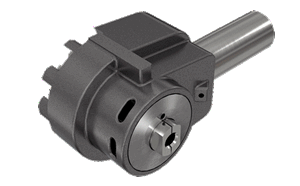Nikon Opens up About Its Strategic Focus on Quality 4.0
Nikon explains its commitment to automated measuring systems and customer relations as the industry continues its focus on Industry 4.0.
A recent interview with Nikon's Corporate Vice President, Tadashi Nakayama provides insight into the strategy of the firm's Industrial Metrology Business Unit, of which he is Deputy General Manager. In particular, he explained the company’s strategic focus on Quality 4.0, where digital, automated and connected inspection enables complete process control from design through manufacture.
The core elements of a Quality 4.0-based process require automated measurement of key features as close to real-time as possible, plus the need to acquire digital results and feed them back directly to control production automatically. In this way, the quality function drives the manufacturing process, guaranteeing the best-possible products.
Digital, automated and connected inspection driving Quality 4.0
Nikon Metrology is committed to ensuring its measuring systems lead the field in Industry 4.0 and this policy was underlined by Mr. Nakayama. At the heart of Quality 4.0 is the interconnection of inspection and production. The goal is to enable manufacturers to produce better products at lower cost, speed up their response to changes in demand, shorten time-to-market and achieve an overall greater competitiveness.
He explained the company's strategic approach to Quality 4.0 is driving three areas: automation of inspection where possible and expedient, digitization of results and integration of metrology data into the production line—allowing processes to be fully optimized. A Quality 4.0-based process improves efficiency and flexibility, both of which are necessary to make companies more competitive.
Unlike Industry 3.0, which was all about mass production, Industry 4.0 includes the possibility of bringing customized goods to the market at similarly competitive prices which gives high-labor-cost countries a competitive edge. This cannot be achieved if products are manufactured according to Industry 3.0, where inspection is often carried out using manual gauges and results are recorded by hand. If parts are detected to be drifting out of tolerance, the process is tuned manually, which takes crucial time and is operator-dependent.
Inspection needs to be digitally integrated into the manufacturing process so it is compatible with analysis software within a central database and thus able to control via a feedback loop. It should also be automatic, especially in small installations or when starting out, to put quality at the center of a factory's operation. Pragmatism and a step-by-step approach are key when making changes in production processes.
The challenge with Quality 4.0 technology is to collect measured results in as near real-time as possible, hence the desirability of automation to speed up the rate at which data is recorded. Additionally, automated evaluation minimizes the risk of human error when interpreting results. Automation of non-contact inspection also allows collection of much larger amounts of data for more meaningful analysis, including trend analysis. In parallel with the flow of information on the components quality, data from the machinery producing them is also acquired.
Artificial intelligence software is then employed to analyze the large amounts of information and correlate the QC data with the CAD model of the component and the machine data. In this way, it is possible to arrive at an understanding of where and why a drift from the center of a tolerance band is occurring so that it can be corrected. Earlier and much better insight into production performance is the result, allowing component accuracy, repeatability, reproducibility and traceability to be ensured with the aim being 100 percent yield.
Quality 4.0 is happening today
Nikon Metrology has already supplied Industry 4.0-enabled QC systems to customers in Europe, Asia and the US. One example in the German automotive industry involves rapid, automatic measurement of the position of studs on the underbody of cars in a production line to an accuracy of 100 microns using multiple Laser Radar systems. Feedback to the stud-welding robots to adjust the process is currently manual, but plans are already in place to close the loop in the near future and automate this part of the procedure.
A major automotive OEM in the US has harnessed another non-contact inspection technique, Nikon Metrology's L100 laser scanner mounted on a coordinate measuring machine, to check pre-production body-in-white panels. In the absence of final press tooling, such pre-series panels have to be CNC-trimmed in 3D by a laser cutter. It is inspection and optimization of this final operation, previously carried out manually over a period of three days, that has been optimized by laser scanning to allow the cutter program to be updated in just four hours.
Within the automotive supply chain, electrical connectors are big business with an average of 2,000 in every vehicle. One such manufacturer, which makes six billion plastic injection-molded connectors per year, has adopted a policy of zero-defect production. It recognizes a faulty part can be an annoyance to a driver, possibly leading to costly warranty repairs, a recall by the OEM or fatal if the connector is part of the vehicle's automatic braking system. For this application, Nikon Metrology supplied a turnkey, shop-floor inspection system with handling equipment and software that automatically loads samples into a computed tomography (CT) scanner. If a housing is out of tolerance, it is rejected and an alarm sent to the operator who stops and adjusts the relevant machine immediately to avoid production of scrap.
Another example is a manufacturer of low-cost chips used to track consumer goods in smart shops that has closed the production to spot and correct for process drift. Nikon Metrology supplied a total solution, including an automatic wafer handler and an iNEXIV video-measuring machine where glass wafers are inspected and the data sent to the plant control to keep circuit pattern dimensions within tolerance.
Future strategy: focus on non-contact total solutions for Quality 4.0
Nikon Metrology's strategy over the next few years will be twofold.
First, from a technical perspective, collection of digital measurement data will be paramount to enable intelligent process control systems, whether local or in the cloud.
The company's core competencies in this area, according to Mr. Nakayama, are laser scanning—including X-ray and CT, which is suitable for high-speed, non-destructive inspection of additively manufactured parts—analysis software, control software and the high-quality optics of its parent group. A fifth area of expertise that contributes to reliable measurement data is precision mechanics, such as the drives on the company's video measuring machines and large-scale Laser Radar scanners.
Artificial intelligence algorithms being developed by partner companies will be utilized increasingly to help analyze QC data, which truly is 'big data' where 2D and 3D clouds of pixels and voxels generated by non-contact inspection are involved.
Secondly, Nikon is increasing the focus on building even stronger relationships with customers. Few in manufacturing miss the trend of a supplier simply delivering a machine and leaving the user to their work, although amazingly it still happens. A 'solution' approach is essential these days and Nikon Metrology is strengthening its offering by entering into long-term business relationships with its global customers, providing support before, during and long after installation of a new process.
Future relationships with customers will be fostered to elevate them to the next level. It will involve continuous dialogue not only about all aspects of the user's installation, but also on subjects as wide-ranging as sales, marketing and even research and development of new products.
Related Content
Large Hybrid Steel Insert Solves Deformation, Dimensionality, Cycle Time Problems
DMLS printers using metal additive powders selected by Linear AMS to produce high-quality, accurate, consistent 3D-printed mold components with certification and traceability.
Read MoreHow to Use Thermal Management to Improve Mold Cooling
A review of common mold cooling issues and possible solutions, including 3D printing applications.
Read More4 Keys to a Successful Mold-Building Operation, The Latest Mold Design Tips & More
MoldMaking Technology is off to a strong start this year with mold design tips, key considerations for running a mold-building “business,” polishing pointers for ribs and more. Check out our list of top-viewed articles from January and see what catches your eye.
Read More3D Printing Enables Better Coolant Delivery in Milling Operations
Just like 3D printing enabled conformal cooling channels in molds, additive manufacturing is now being used to optimize coolant delivery in cutting tools.
Read MoreRead Next
How to Use Strategic Planning Tools, Data to Manage the Human Side of Business
Q&A with Marion Wells, MMT EAB member and founder of Human Asset Management.
Read MoreReasons to Use Fiber Lasers for Mold Cleaning
Fiber lasers offer a simplicity, speed, control and portability, minimizing mold cleaning risks.
Read MoreHow to Use Continuing Education to Remain Competitive in Moldmaking
Continued training helps moldmakers make tooling decisions and properly use the latest cutting tool to efficiently machine high-quality molds.
Read More























